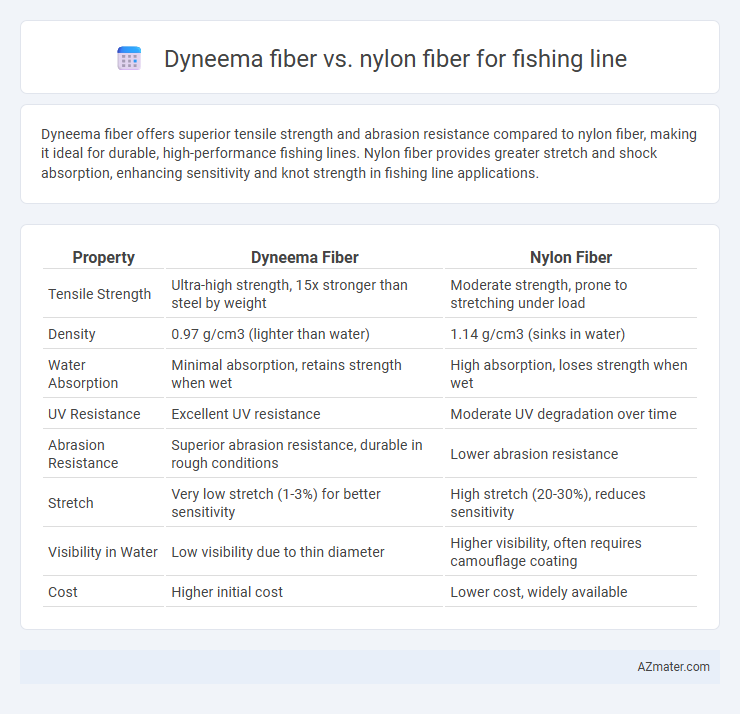Dyneema fiber offers superior tensile strength and abrasion resistance compared to nylon fiber, making it ideal for durable, high-performance fishing lines. Nylon fiber provides greater stretch and shock absorption, enhancing sensitivity and knot strength in fishing line applications.
Table of Comparison
| Property | Dyneema Fiber | Nylon Fiber |
|---|---|---|
| Tensile Strength | Ultra-high strength, 15x stronger than steel by weight | Moderate strength, prone to stretching under load |
| Density | 0.97 g/cm3 (lighter than water) | 1.14 g/cm3 (sinks in water) |
| Water Absorption | Minimal absorption, retains strength when wet | High absorption, loses strength when wet |
| UV Resistance | Excellent UV resistance | Moderate UV degradation over time |
| Abrasion Resistance | Superior abrasion resistance, durable in rough conditions | Lower abrasion resistance |
| Stretch | Very low stretch (1-3%) for better sensitivity | High stretch (20-30%), reduces sensitivity |
| Visibility in Water | Low visibility due to thin diameter | Higher visibility, often requires camouflage coating |
| Cost | Higher initial cost | Lower cost, widely available |
Introduction to Fishing Line Materials
Dyneema fiber, known for its ultra-high molecular weight polyethylene composition, offers exceptional strength-to-weight ratio and superior abrasion resistance compared to traditional Nylon fiber. Nylon fiber, a widely used fishing line material, provides excellent elasticity and knot strength but tends to absorb water, leading to reduced durability over time. Choosing Dyneema fiber results in a lightweight, durable fishing line with minimal stretch, ideal for sensitive bite detection and long-lasting performance.
What is Dyneema Fiber?
Dyneema fiber is an ultra-high-molecular-weight polyethylene (UHMWPE) known for its exceptional strength-to-weight ratio, making it a premier choice for fishing lines that require durability and abrasion resistance. Compared to nylon fiber, Dyneema offers superior tensile strength and lower stretch, enhancing sensitivity and hook-setting power in fishing applications. Its resistance to UV light, water absorption, and chemicals ensures long-lasting performance in harsh marine environments.
What is Nylon Fiber?
Nylon fiber, a synthetic polymer known for its strength and elasticity, is commonly used in fishing lines due to its excellent knot strength and abrasion resistance. Compared to Dyneema fiber, nylon offers greater stretch, which helps absorb shock from sudden fish movements but may reduce sensitivity. While Dyneema provides superior tensile strength and low stretch, nylon remains a cost-effective and versatile option favored in various fishing applications.
Strength and Durability Comparison
Dyneema fiber exhibits significantly higher tensile strength compared to nylon fiber, making it more resistant to breaking under heavy loads in fishing lines. Its ultra-high molecular weight polyethylene composition provides superior abrasion resistance and minimal water absorption, enhancing durability in harsh saltwater and freshwater environments. Nylon tends to stretch more under tension, which can reduce sensitivity and long-term durability when exposed to UV rays and repeated stress.
Stretch and Sensitivity Differences
Dyneema fiber fishing lines have significantly lower stretch compared to nylon fibers, providing superior sensitivity to bites and underwater movements. The minimal elongation of Dyneema allows anglers to detect subtle nibbles and maintain better control over the lure or bait. In contrast, nylon fibers offer higher stretch, which can absorb shocks but reduce overall sensitivity and bite detection accuracy.
Abrasion Resistance: Dyneema vs. Nylon
Dyneema fiber exhibits superior abrasion resistance compared to Nylon fiber, making it highly durable for fishing lines exposed to rough underwater surfaces and sharp rocks. Dyneema's ultra-high molecular weight polyethylene (UHMWPE) structure provides exceptional toughness and maintains strength even under repeated frictional stress. Nylon, while flexible and elastic, tends to wear down faster with surface abrasion, reducing its longevity and effectiveness in challenging fishing environments.
Water Absorption and Weather Performance
Dyneema fiber exhibits extremely low water absorption, maintaining its tensile strength and flexibility even after prolonged exposure to water, which enhances its durability in fishing line applications. Nylon fiber tends to absorb more water, leading to swelling and reduced strength that can compromise line performance over time. Dyneema also demonstrates superior resistance to UV degradation and harsh weather conditions, ensuring longer lifespan and consistent reliability in diverse fishing environments.
Knot Strength and Handling
Dyneema fiber offers superior knot strength compared to nylon fiber, maintaining high tensile strength even at tight knots, which reduces line slippage or breakage during fishing. Its low stretch characteristic ensures better sensitivity and precise handling, allowing anglers to detect subtle bites more effectively than elastic nylon lines. Nylon fiber, while more elastic and easier to knot, tends to lose strength at knots and can result in less accurate feedback and increased line stretch during use.
Cost Considerations
Dyneema fiber fishing lines generally have a higher upfront cost compared to nylon due to their superior strength-to-weight ratio and durability. Nylon lines tend to be more budget-friendly but may require more frequent replacement because they are prone to abrasion and stretch. Evaluating long-term expenses reveals that Dyneema's enhanced longevity can offset initial costs, making it a cost-effective choice for serious anglers.
Choosing the Right Fiber for Your Fishing Needs
Dyneema fiber offers superior tensile strength and abrasion resistance compared to nylon fiber, making it ideal for anglers targeting large or sharp-toothed species. Nylon fiber provides greater stretch and cushioning, which helps absorb shocks and is preferable for delicate presentations or lighter tackle. Selecting the right fiber depends on fishing conditions, species targeted, and desired sensitivity, balancing strength and flexibility for optimal performance.

Infographic: Dyneema fiber vs Nylon fiber for Fishing line
 azmater.com
azmater.com